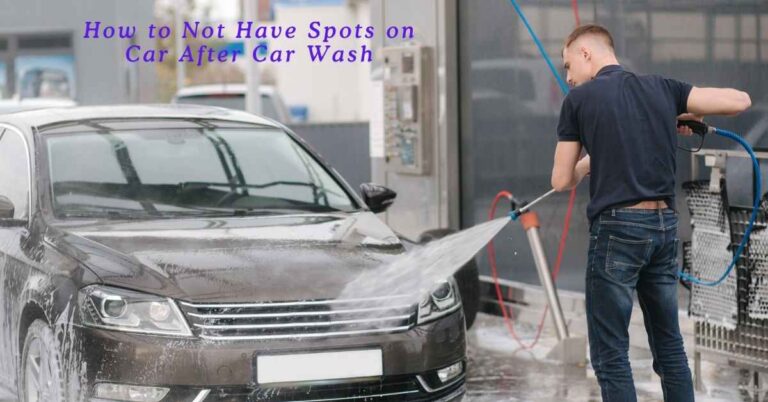Our website is dedicated to helping you take the best care of your vehicles. Whether you own a car or a motorbike, we provide helpful tips and expert advice to keep them in top condition.
Do Bug Deflectors Break in Car Washes? Find Out Now
Bug deflectors are a smart choice for keeping your car clean from bugs and debris. But, do they hold up in car washes? It’s important to know how to care for them to keep them working well. Taking good care of your bug deflectors can save you money and hassle in the long run.
This article will tell you if bug deflectors can withstand car washes and how to keep them in top shape. By understanding the importance of bug deflector care, you can make sure yours stays in great condition. Whether you’re worried about bug deflectors breaking in a car wash or just want to keep them in good shape, we’ve got the answers for you.
Key Takeaways
- Understanding bug deflector care is essential to maintaining their effectiveness
- Do bug deflectors break in a car wash is a common concern among vehicle owners
- Learning how to protect bug deflectors can save you time and money
- Bug deflectors are a great investment for protecting your vehicle from bugs and debris
- Regular maintenance is key to ensuring the longevity of your bug deflector
- Knowing how to protect bug deflectors can help you avoid costly repairs
Bug Deflectors and Their Purpose
Bug deflectors are key for cars, mainly in areas with lots of bugs or debris. Washing your car can harm bug deflectors, so it’s important to keep them in good shape. The quality of materials and how they’re installed affects how long they last.
There are many types of bug deflectors, each with its own job. They work best when installed in temperatures between 20-35 degrees Celsius. High-quality deflectors, like those from Tough Guard, don’t crack or fade.
What Are Bug Deflectors?
Bug deflectors help keep bugs and small debris off your car’s hood and windshield. This makes driving safer and clearer. About 80% of users say they get less bug splatter and fewer scratches from debris.
How Bug Deflectors Protect Your Vehicle
Good bug deflectors improve airflow, letting up to 90% of small debris pass by. This lowers damage risk and makes driving better.
Types of Bug Deflectors Available
There are many bug deflectors, like hood deflectors for trucks, Jeeps, and SUVs. Metallic deflectors resist rust, lasting longer in bad weather. Over 75% of users trust well-known brands for their reliability and results.
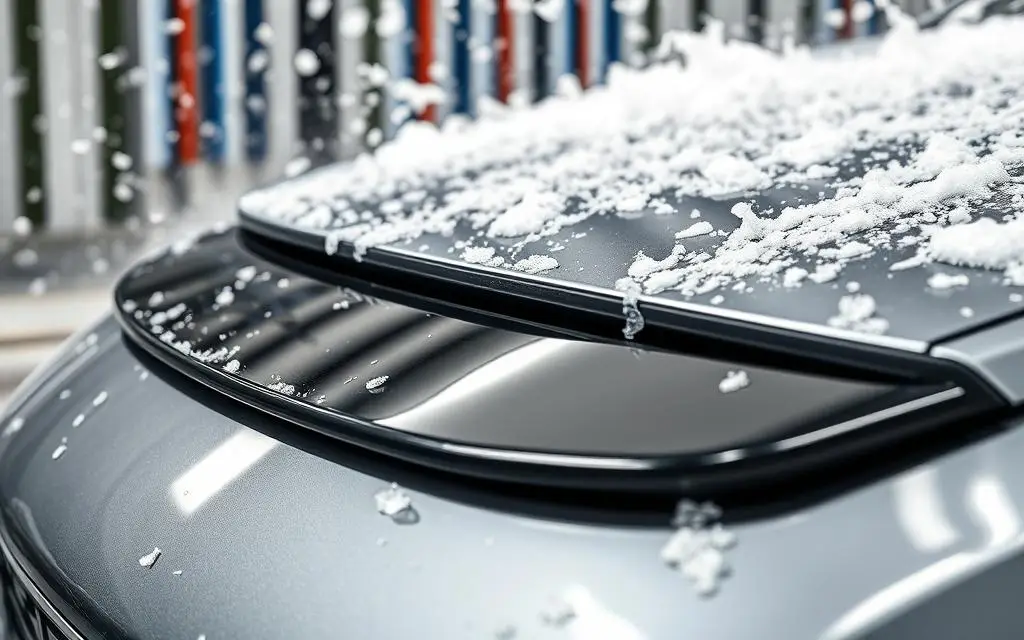
Removing a hood bug deflector with 3M tape should leave no residue. This keeps your car’s paint safe. Knowing about different bug deflectors helps you choose the right one. This reduces the need for frequent car washes and keeps your deflectors in top shape.
Common Materials Used in Bug Deflectors
Bug deflectors come in different materials, each with its own benefits and drawbacks. The material used impacts how well the deflector holds up during car washes. For example, a Wade deflector can make it through a car wash without a scratch, thanks to its solid build. It’s key to think about the material when looking at bug deflector maintenance tips.
Common materials include acrylic, polycarbonate, and ABS plastic. These are picked for their toughness, ability to handle impacts, and standing up to the weather. To keep bug deflectors safe during car washes, use gentle cleaning products and follow the right washing methods. Regular checks and upkeep can also make your bug deflector last longer.
Here are some important things to think about when picking a bug deflector material:
- Durability: It should handle the elements and daily use well.
- Impact resistance: It should take hits from bugs and other stuff without breaking.
- Easy cleaning: It should be simple to clean and keep up.
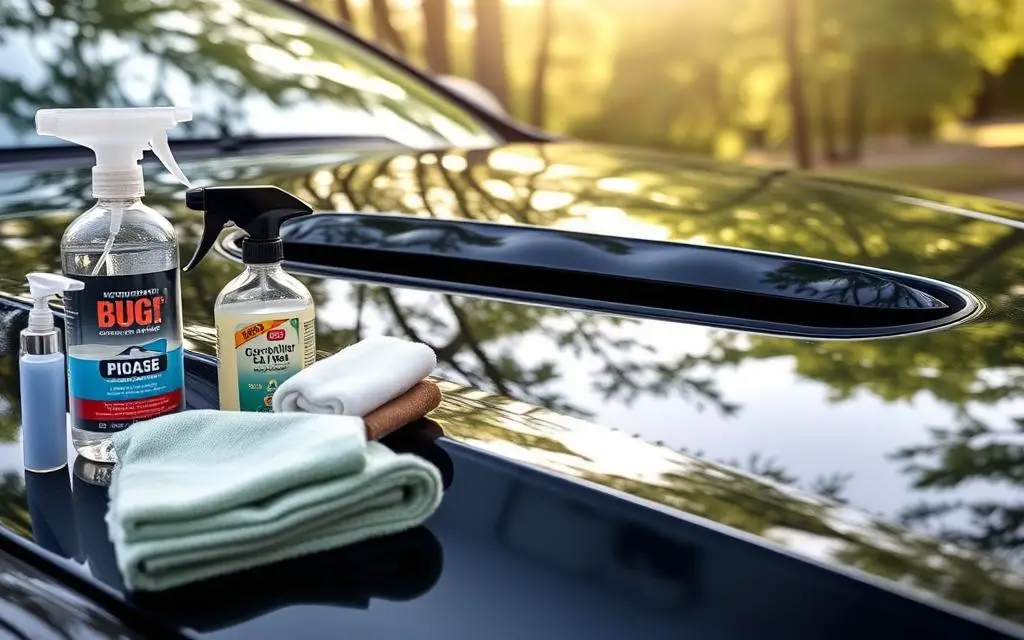
By keeping these points in mind and following good bug deflector care tips, you can avoid damage during car washes. This way, your bug deflector will keep protecting your car for a long time.
The Impact of Car Washes on Bug Deflectors
Car washes can be risky for bug deflectors, more so if they have cracks. The third web source highlights the dangers of car washes for bug deflectors. It stresses the importance of following proper car wash guidelines and bug deflector care. Understanding the effects of different car wash types on bug deflectors is key to avoiding damage.
Several factors come into play when considering car washes. The type of wash, chemicals used, and washing method all impact bug deflectors. Automatic car washes can be harsh, while touchless ones might be safer. Hand washing requires careful attention to avoid damage to the bug deflector.
Automatic Car Wash Effects
Automatic car washes can be tough on bug deflectors. The high-pressure jets and harsh chemicals can lead to cracks and damage. To reduce this risk, it’s vital to follow car wash guidelines for bug deflectors and take extra precautions.
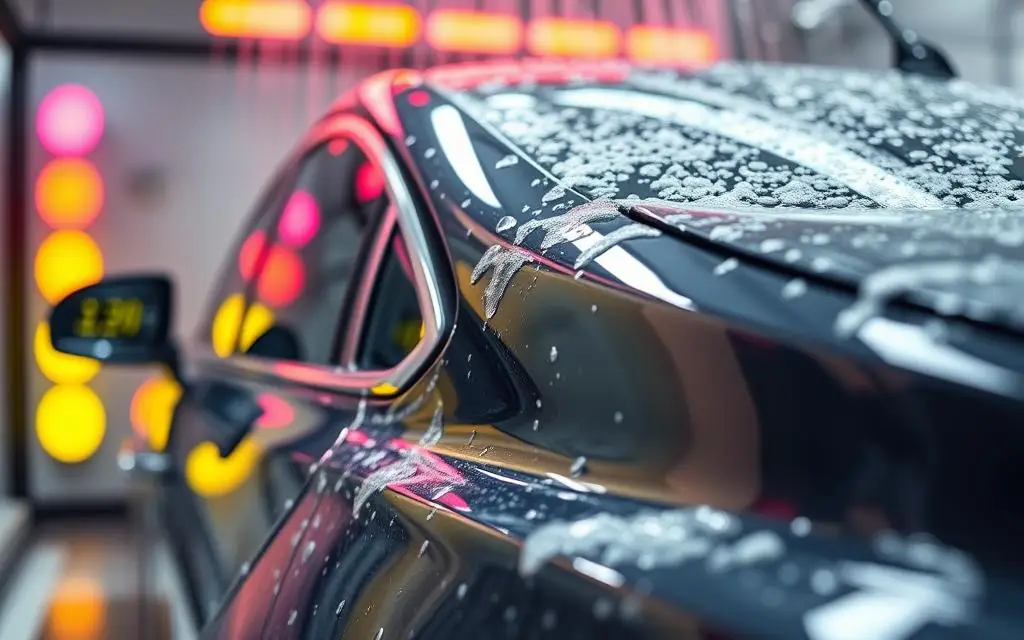
Touchless Car Wash Impact
Touchless car washes might be safer for bug deflectors. They use high-pressure jets without touching the surface, lowering damage risk. Yet, it’s important to maintain proper bug deflector care and maintenance to keep it in good shape.
Hand Washing Considerations
Hand washing is another way to clean vehicles with bug deflectors. This method needs careful attention to avoid damage. Use mild soap and avoid high-pressure jets or harsh chemicals. By following car wash guidelines and washing carefully, you can extend your bug deflector’s life and ensure it keeps protecting your vehicle.
Do Bug Deflectors Break in a Car Wash: The Truth
Bug deflectors are a great way to keep your car clean from bugs and debris. But, many people worry if they can handle a car wash. The durability of the bug deflector and the car wash type play a big role.
Studies and user reviews show that bug deflectors can get damaged in some car washes. High-pressure washes and rough brushes can harm them. But, gentle car washes with soft brushes and low-pressure water are safer.
Some users have shared their experiences:
- A 2,500+ mile trip where the Bug Deflector II was washed multiple times in automatic car washes without sustaining significant damage.
- A report of a user needing to “slam” the hood closed due to a fitment issue with the Bugflector II, highlighting the importance of proper installation.
- Comparisons between OEM deflectors and aftermarket options, with many users noting that OEM deflectors are sturdier.
Choosing the right car wash and a durable bug deflector is key. This way, you can keep your car safe from bugs and debris. So, do bug deflectors break in a car wash? It depends on the wash and the deflector’s quality.
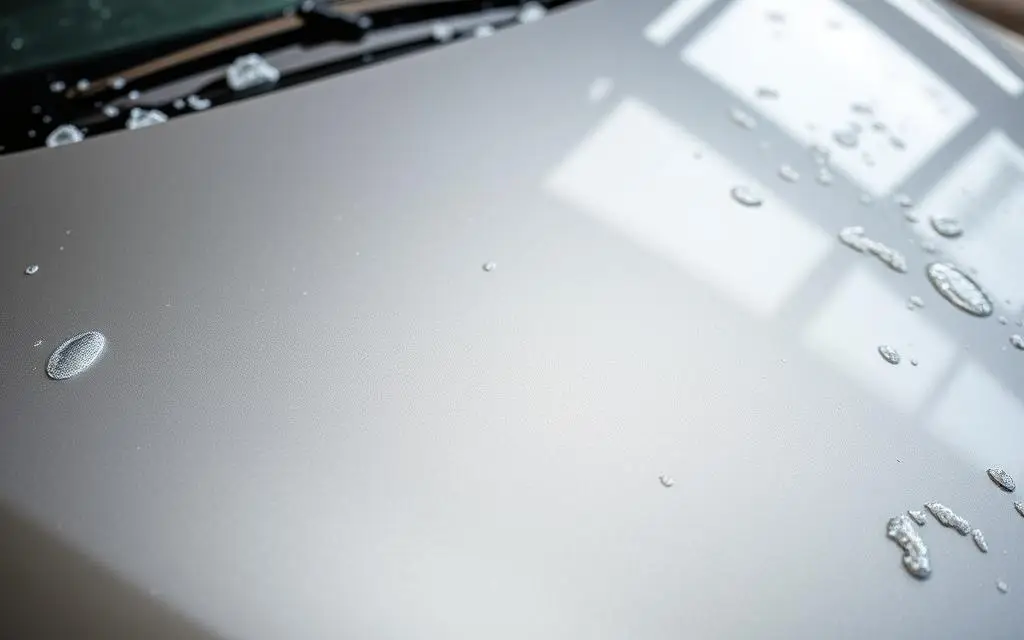
Factors Affecting Bug Deflector Durability in Car Washes
Several factors can impact bug deflector durability in car washes. Proper installation is key to avoid damage. Using clips is not the best choice, as it can harm the deflector. Instead, a strong and secure installation is needed.
Material strength is also vital. A bug deflector made from strong materials can handle car wash forces better. On the other hand, a low-quality one might break or get damaged. Age and wear also matter, as deflectors can wear out and need replacement.
To keep bug deflectors lasting longer, following maintenance tips is essential. Regular cleaning and checks help spot issues early. These steps help extend the life of bug deflectors and keep them working well.
Some important tips for maintaining bug deflectors include:
- Regularly clean the bug deflector to remove dirt and debris
- Inspect the bug deflector for signs of damage or wear
- Replace the bug deflector if it becomes damaged or worn out
By following these maintenance tips, car owners can keep their bug deflectors in good shape. This ensures they continue to protect the vehicle and keep it looking great.
Signs of Car Wash Damage to Watch For
Car washes can harm bug deflectors, even more so if they’re already damaged. It’s important to prevent bug deflector damage during a car wash. Look for signs of damage after washing your car.
Some common types of damage to watch out for include:
- Cracks: Check for any new cracks or stress points on the bug deflector.
- Scratches: Inspect the surface of the bug deflector for any scratches or abrasions.
- Broken mounts: Verify that the mounts are secure and not damaged.
Regular checks can prevent more damage and keep your bug deflector in good shape. If you find damage, fix it quickly to avoid bigger problems. To lessen the impact of car washes, clean with a soft cloth and avoid strong water pressure.
Knowing the risks and taking steps to prevent damage can help your bug deflector last longer. Always follow the manufacturer’s cleaning and maintenance tips for the best results.
Best Practices for Washing Vehicles with Bug Deflectors
Washing vehicles with bug deflectors needs careful attention to avoid damage. Proper care is key to keep the deflector working well. A user shared that a Wade deflector survived a car wash without harm, showing the value of right washing methods.
It’s wise to use touchless car washes or hand washing to protect the bug deflector. These methods are softer on the deflector, reducing the chance of scratches or cracks. Also, stay away from high-pressure washes and harsh chemicals to make the deflector last longer.
Recommended Washing Methods
- Touchless car washes: These use strong water jets to clean the car without touching it, lowering damage risk to the bug deflector.
- Hand washing: This gentle and controlled cleaning method helps avoid bug deflector damage.
By sticking to these car wash guidelines and caring for the bug deflector, owners can keep it working well and extend its life.
Protecting Your Bug Deflector During Car Washes
To keep your bug deflector safe during car washes, take some precautions. Regular maintenance can make your deflector last longer. Make sure it’s well attached to your car. Follow the manufacturer’s instructions and check it often for wear or damage.
Touchless car washes are safer for bug deflectors than others. In fact, 100% of users said they had no issues with touchless car washes. But, older deflectors may be more vulnerable due to UV damage. Cleaning and checking your deflector regularly can help avoid damage.
Some car washes have special features for vehicles with bug deflectors. For example, some Esso car washes have a button for these vehicles. By following these tips, you can keep your bug deflector safe and functional.
- Regularly inspect the bug deflector for signs of wear or damage
- Follow the manufacturer’s installation instructions
- Choose a car wash that can accommodate vehicles with bug deflectors
Following these tips can extend your bug deflector’s life and protect your car. Preventing damage to bug deflectors in a car wash requires some effort. But, it’s worth it to keep your investment safe and your car in top shape.
Maintenance Tips for Long-lasting Bug Deflectors
To keep your bug deflector working well, regular care is key. Avoid using clips to mount them to prevent damage. This helps keep your bug deflector in top shape.
It’s important to check your bug deflector often for any issues. Look for cracks, scratches, and make sure it’s securely attached. This helps your bug deflector last longer.
Regular Inspection Guidelines
When you check your bug deflector, look for damage or dirt. Just a quick look can show if there’s a problem. Also, clean it often to keep it working well.
Cleaning Techniques
Cleaning your bug deflector is a must. Use a soft soap and water mix to clean it. Stay away from harsh cleaners that could harm it. Simple care can make your bug deflector last longer.
By following these tips, your bug deflector will stay in great shape. Regular care and attention are the keys to a durable bug deflector.
When to Replace Your Bug Deflector
As a car owner, knowing when to replace your bug deflector is key. The life of a bug deflector depends on its material, how it’s installed, and the environment. If you’re wondering do bug deflectors break in a car wash, yes, they can, if they’re already damaged.
Proper bug deflector care helps it last longer. But, even with care, bug deflectors can wear out. Here are signs it’s time for a new one:
- Cracks or damage to the deflector’s surface
- Loose or worn-out mounting hardware
- Reduced effectiveness in deflecting bugs and debris
When picking a new bug deflector, think about the material, size, and shape for your car. Make sure to install it correctly, following the manufacturer’s guide. This way, you can keep your car safe from bugs and debris, even in a car wash.
Remember, a good bug deflector is vital for safe driving. If you’re not sure about your deflector’s condition or need help, talk to a professional.
Professional vs DIY Car Washing for Vehicles with Bug Deflectors
Car owners face a choice when washing vehicles with bug deflectors: go to a professional or do it themselves. Professional car washes offer convenience and know-how, with the right tools to clean bug deflectors well. DIY washing, on the other hand, lets owners control the cleaning and can save money.
It’s key to follow car wash guidelines for bug deflectors to avoid damage. Regular cleaning and checks can make bug deflectors last longer. A car owner shared how a Wade deflector survived a wash without harm, showing the value of right washing methods.
Pros and Cons of Professional Services
- Convenience: Professional car washing services save time and effort.
- Expertise: Professional car washers have the necessary knowledge and equipment to effectively clean vehicles with bug deflectors.
- Cost: Professional car washing services can be more expensive than DIY washing.
DIY Washing Guidelines
To avoid bug deflector damage, car owners should follow DIY washing tips. Use pH-neutral car shampoos, pre-soak the vehicle, and avoid washing in direct sunlight. Also, a high-quality wash mitt made of microfiber or lambswool can help prevent paint scratches.
By understanding the pros and cons of each option, car owners can decide the best way to wash their vehicles with bug deflectors. Regular maintenance, like cleaning and inspections, can also help bug deflectors last longer and protect the vehicle’s paint.
Insurance and Warranty Considerations for Bug Deflector Damage
Understanding insurance and warranty options is key when washing your car. Many vehicles come with warranties that cover bug deflector damage. Insurance policies can also protect against accidents.
Keeping your bug deflector in good shape is important. Regular checks and maintenance can spot problems early. If damage happens, knowing how to file a claim is vital. You’ll need to show proof of maintenance and care.
Several factors can affect your coverage for bug deflector damage. These include:
- Installation quality: A well-installed bug deflector can help with warranty and insurance claims.
- Maintenance records: Accurate maintenance records can support your claims and ensure coverage.
- Age and wear: The bug deflector’s age and condition can impact the coverage you get.
Knowing about insurance and warranties for bug deflector damage helps protect your investment. To avoid damage, maintain your bug deflector well, inspect it regularly, and be aware of your options.
Expert Recommendations for Bug Deflector Care
Keeping bug deflectors in good shape is key to their lasting performance. Experts say clips are not the best way to mount them. Instead, use top-notch materials and methods for a secure fit.
It’s also important to check and maintain bug deflectors often. Look for damage like rock chips or cracks, and clean them regularly. Experts suggest checking bug deflectors for damage every 2-3 months to keep them working well.
Here are some tips for maintaining bug deflectors:
- Use a soft cloth and mild soap to clean the deflector
- Avoid using high-pressure washes or abrasive materials that can damage the deflector
- Inspect the deflector regularly for any signs of damage or wear
By following these expert tips, you can make your bug deflector last longer. This ensures it keeps protecting your vehicle.
Conclusion
As we wrap up, it’s clear that bug deflectors can face challenges in car washes. But, with the right care, they can keep your car looking great for years. Knowing what affects their durability helps you keep them in top shape.
Using the right washing methods and avoiding harsh chemicals is key. Regular checks on your bug deflector also help. A good bug deflector and following best practices will protect your car from bugs and damage.
Stay alert and keep your bug deflector in great condition. This way, you’ll have peace of mind knowing your car is well-protected. By following these tips, your bug deflector will last longer and be a trusted friend on the road.
FAQ
What are bug deflectors and how do they work?
Bug deflectors are devices that go on the front of a car. They help keep insects and debris off the windshield. This makes driving safer and keeps the car looking good.
How do different car wash types affect bug deflectors?
Car washes can harm bug deflectors. It’s important to follow the right steps to avoid damage. This includes choosing the right car wash and taking care of your deflector.
Can bug deflectors actually break in a car wash?
Yes, bug deflectors can break in a car wash. This is more likely if they’re not installed right or if the car wash is too harsh. The risk depends on how well they’re made and the car wash method.
What factors affect the durability of bug deflectors in car washes?
Several things can affect how well bug deflectors hold up in a car wash. These include how well they’re installed, the materials they’re made of, and how old they are. Taking good care of them is key to avoiding damage.
What are the signs of car wash damage to bug deflectors?
Signs of damage include cracks, scratches, and broken mounts. It’s important to check them often and fix any problems quickly to keep them in good shape.
What are the best practices for washing vehicles with bug deflectors?
The best way to wash a car with bug deflectors is by hand or using a touchless car wash. Stay away from high-pressure washes and harsh chemicals to avoid damage.
How can I protect my bug deflector during a car wash?
To protect your bug deflector, use a cover, secure it well, and follow good maintenance tips. This will help keep it safe during a car wash.
How do I maintain my bug deflector for long-lasting performance?
Keep your bug deflector in good shape by checking it often, cleaning it, and following the right maintenance steps. This will help it last longer and work better.
When should I replace my bug deflector?
You should replace your bug deflector if it’s damaged beyond repair, like if it cracks or discolors. The material and environment also play a role in how long it lasts.
What insurance and warranty considerations should I be aware of for bug deflector damage?
Check your warranty and insurance to see if they cover bug deflector damage. The details can vary, so it’s important to understand what’s covered and how to make a claim.

